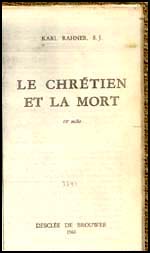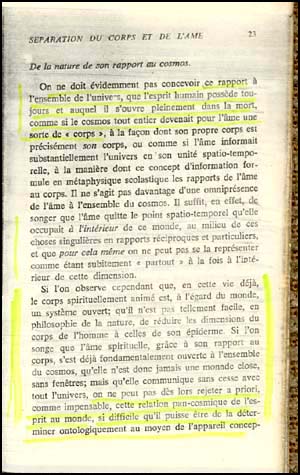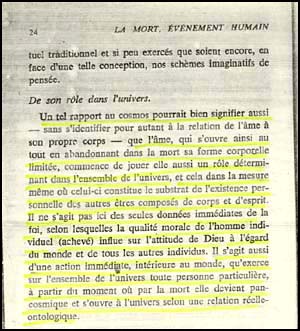The optimistic counsel that Pope Benedict XVI gave on November 1, to "think without fear about the mystery of death," as well as his unrestricted affirmation that "the new life, received in Baptism, is not subjected to corruption nor the power of death" (Zenit, November 2, 2005) makes one wonder: What conception of death was the presupposition of such curious statements in apparent discordance with Catholic doctrine?
Indeed, it is common Catholic knowledge that the life of sanctifying grace received in Baptism can be corrupted by any mortal sin. Catholics are also habitually counseled to fear death and their particular Judgment before God. The grandious canticle Dies Irae [the day of God's ire] sung at the Mass of the Dead applies to each one of us and reflects well the wise stance of the Catholic Church on the topic.
How can such an apparent variance between the Pope's affirmations and the traditional Catholic teaching be explained?
We went to the work of Karl Rahner, mentor of the young Fr. Joseph Ratzinger, looking for an explanation.
In his book The Christian and Death, Fr. Rahner defends the strange thesis that after death, the soul of each man reintegrates in the ensemble of the universe in a "pan-cosmic" way - read pantheistic way - and from the cosmos, it acts over persons who are still alive.
His conception of what happens to the soul after death no longer relies on whether a person was good or bad in his life on earth; rather life after death would occur by an ontological need of a supposedly evolutionist process that would encompass both God and men, as well as the rest of the universe.
The allocution of Benedict XVI was short and did not provide enough elements for one to know whether his conception of death is the same as Rahner's.
Therefore, we offer the reader Rahner's document only as a point of reference to know what the progressivist thinking on this topic is.
Top right is a picture of the book's frontispice; at right, photocopies of the French text. Below, we present our translation.
After affirming that the souls of animals are integrated in the cosmos after their deaths, Rahner continues:
One senses that a similar thing happens in the relations of the spiritual soul with the universe .... Death does not make the [human] soul a-cosmic, but rather one would say, pan-cosmic.
This relation that the human soul always has with the ensemble of the universe and to which the soul fully opens itself in death should obviously not be conceived as if the whole cosmos would become a kind of body for the soul .... Also the soul does not become omnipresent in the universe. ...
However, if one observes that already in this life the spiritually animated body is an open system toward the universe .... If one considers that the spiritual soul, thanks to its relations with its body, is already fundamentally open to the ensemble of the cosmos and, consequently, is not a closed unit without windows .... Then, one cannot reject a priori this pan-cosmic relation of the soul with the universe. ...
Such a relation could signify that the soul, which in death opens itself to everything by abandoning its limited corporal form, starts to play a deciding role in the ensemble of the universe, insomuch as the cosmos constitutes the substrate of the personal existence of other human beings. What matters is no longer just the immediate data of the faith, according to which the moral qualities of the individual man influence the attitude of God toward the universe and other individuals. Rather, it is an immediate action, interior to the universe, that each particular person exerts over the ensemble of the universe from the moment when, through death, he becomes pan-cosmic and opens himself to the universe in a real and ontological relation.
(Le Chretien et la Mort, Paris: Desclee de Brower, 1966 pp. 22-24).
|




|

Posted on November 6, 2005
|
